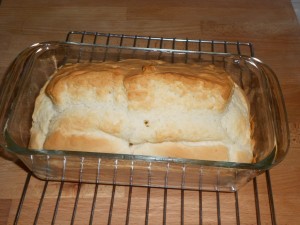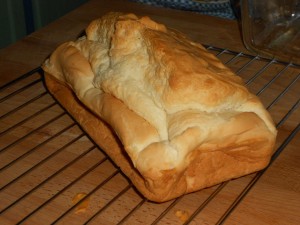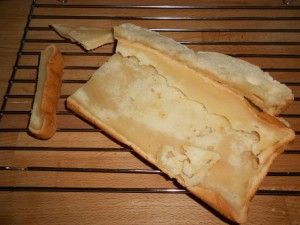I’ve just added this recipe to the “Bread Diary” but I’m also giving it its own post because it proves that you do not need a stand mixer OR bread machine to bake GF bread. My stand mixer broke on the last batch of GF bread dough (and I’ve never owned a bread machine) so I decided to throw caution to the wind and see how it would work to mix the dough by hand. I think one of the keys is that you need to allow the “gums” time to absorb moisture. In most recipes this is accomplished by mixing/kneading the dough (using a machine) for 5-10 minutes. I don’t have the strength to mix that long by hand, but gradually adding the ingredients and then mixing and waiting a bit and mixing some more seemed to work!
Baked on March 13, 2012
High Fiber Bread—gluten-free, dairy-free, corn-free
adapted from
Beth and Jen’s High Fiber Bread [p. 36 in Gluten-Free Makeovers by Beth Hillson (2011, DaCapo/LifeLong/Perseus Book Group, Cambridge, MA)]
I only recently discovered amaranth and have yet to try baking with amaranth flour . . . this bread is my first attempt. It definitely has that distinctive “amaranth odor/taste” combined with the equally distinctive “teff odor/taste”. Certainly hearty, like a good whole wheat bread.
The original recipe says: “Makes One 2-pound loaf or 16 slices” which is a bit confusing because it also says to use an 8-1/2″ x 4-1/2″ loaf pan (which is usually thought of as a 1 pound loaf pan). One more of the many confusing aspects of GF baking. I was tempted to use my 10″x5″ loaf pan, but followed the directions and was glad I did.
The ingredients were given in cups and grams. Due to all the substituting I was doing, I used the weights (because the same quantity of a different flour will weigh a different amount, it is generally recommended to use weight rather than volume, especially when substituting) . . . but took note of the volumes that resulted and listed them as well.
The final complication came from no longer having a stand mixer (broke it making the previous loaf of thick gluten-free bread batter) . . . SO, I went back to my old knowledge of mixing bread dough by hand and added a bit of gluten-free common sense (e.g., you do NOT want to try to “knead” GF “dough” by hand . . . much too sticky!). Here’s what I did:
Equipment you will need:
- 8-1/2″ x 4-1/2″ loaf pan
- several mixing bowls of various sizes
- a VERY sturdy wooden spoon or “Danish Dough Whisk”

Ingredients
- 1/3 cup millet flour (54 grams)
- 2/3 cup amaranth flour (65 grams)
- 1/3 cup teff flour (48 grams)
- 2/3 cup sorghum flour (80 grams)
- 1/2 cup arrowroot starch (65 grams)
- 1/2 cup tapioca flour (70 grams)
- 3-1/2 tsp guar gum
- 1 tsp salt
- 1/4 tsp cream of tartar
- 3 Tbls brown sugar, packed, divided (46 grams)
- 3 large eggs, lightly beaten
- 3 Tbls vegetable oil
- 1-1/8 cups warm water (110°F), divided
- 2-1/4 tsp active dry yeast
Directions
- Lightly oil an 8-1/2″ x 4-1/2″ sandwich loaf pan.
- Measure/weigh the six “flours” (first 6 ingredients) and combine in a medium bowl. Add guar gum, salt, and cream of tartar. Stir/whisk to mix. Measure the brown sugar, reserving 1 tsp in a small bowl for use in proofing the yeast. Sprinkle the rest of the brown sugar 2-2/3 Tbls) over the other dry ingredients.
- Pour 1/2 cup of the warm water over the brown sugar in the small bowl. Sprinkle the yeast over the sugar water. Stir to dissolve. Allow to rest for 10 minutes or until foamy. Reserve the remaining 5/8 cup water.
- Lightly beat the eggs and oil in a separate medium bowl.
- Once the yeast is ready, put about 1 cup of the dry ingredients into a large sturdy bowl. Add the yeast mixture and stir with a heavy wooden spoon or “dough whisk”. Add the egg/oil mixture and stir. Alternately (and gradually) add the remaining dry ingredients and the remaining water (dry-water-dry-water-dry) stirring after each addition. The dough/batter will be VERY thick.
- Allow to rest for a few minutes (the gum needs to absorb water) and then stir again.
- Scrape the dough into the prepared pan. Cover with oiled plastic wrap and set in a warm, draft-free place to rise for 40-60 minutes, or just until the dough has risen nearly to the top of the pan. Remove the plastic wrap. [Here in Minnesota this always takes longer than the recipes indicate! Be patient!]
- Preheat the oven to 350°F while the dough makes its final rise to the top of the pan (if you’ve been letting it rise in the oven, here’s where you take it out!! 🙂 ). Bake the dough on the center rack for 40-50 minutes or until an instant-read thermometer inserted in the loaf reads 200°F. [I rotate the loaf halfway through the baking time.]
- Remove the pan to a wire rack and allow to cool for 10 minutes. Turn out and allow to cool completely.
See additional Notes below the pictures

Yes, the dough needs to be THIS thick, or it will collapse.




Left: half way through baking; Right: end of baking, already dipping in the center.



On the left is the millet-oat bread I made last week in the 10″x5″ pan; on the right is today’s bread made in the 8-1/2″ x 4-1/2″ sandwich bread pan. Goal: a 10″x5″ loaf that rises as high as today’s smaller loaf . . . I’m not really into “dainty” sandwiches! Still, this loaf didn’t taste bad . . . but definitely amaranth-y.
Notes
- I baked mine for 50 minutes, but even though the internal temp was 205°F, the center didn’t look/feel “done” and looked like it would collapse. I tried turning off the oven and allowing it to cool for about 15 minutes in the still-warm oven. Won’t know how mushy the middle is until I cut into it some more. There has already been some collapsing a few hours later. [Note: the interior texture is a bit on the moist/tender side, but toasting takes care of that. No major raw or mushiness inside. Still looking for the GFBread Recipe that I can eat without toasting first!]
- After much searching on the interwebs (and reading contradictory information in various cookbooks). I’ve decided that even if some people believe you no longer need to “proof” yeast, if I’m using active dry yeast, I will proof it. If I don’t want to bother with proofing, I will use RapidRise or “instant” yeast mixed in with the dry ingredients and slightly warmer water (120°-130°F).
- BTW—getting GF bread dough to rise and then not collapse after baking are the two biggest challenges I’ve run into so far.

























